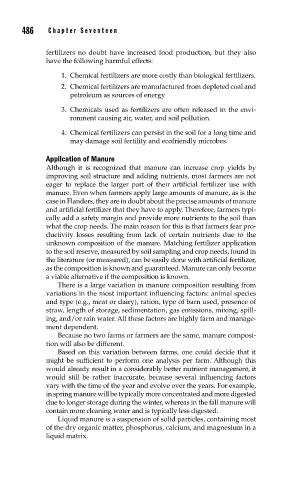Page 514 - Biosystems Engineering
P. 514
486 Cha pte r Se v e ntee n
fertilizers no doubt have increased food production, but they also
have the following harmful effects:
1. Chemical fertilizers are more costly than biological fertilizers.
2. Chemical fertilizers are manufactured from depleted coal and
petroleum as sources of energy
3. Chemicals used as fertilizers are often released in the envi-
ronment causing air, water, and soil pollution.
4. Chemical fertilizers can persist in the soil for a long time and
may damage soil fertility and ecofriendly microbes.
Application of Manure
Although it is recognized that manure can increase crop yields by
improving soil structure and adding nutrients, most farmers are not
eager to replace the larger part of their artificial fertilizer use with
manure. Even when farmers apply large amounts of manure, as is the
case in Flanders, they are in doubt about the precise amounts of manure
and artificial fertilizer that they have to apply. Therefore, farmers typi-
cally add a safety margin and provide more nutrients to the soil than
what the crop needs. The main reason for this is that farmers fear pro-
ductivity losses resulting from lack of certain nutrients due to the
unknown composition of the manure. Matching fertilizer application
to the soil reserve, measured by soil sampling and crop needs, found in
the literature (or measured), can be easily done with artificial fertilizer,
as the composition is known and guaranteed. Manure can only become
a viable alternative if the composition is known.
There is a large variation in manure composition resulting from
variations in the most important influencing factors: animal species
and type (e.g., meat or dairy), ration, type of barn used, presence of
straw, length of storage, sedimentation, gas emissions, mixing, spill-
ing, and/or rain water. All these factors are highly farm and manage-
ment dependent.
Because no two farms or farmers are the same, manure composi-
tion will also be different.
Based on this variation between farms, one could decide that it
might be sufficient to perform one analysis per farm. Although this
would already result in a considerably better nutrient management, it
would still be rather inaccurate, because several influencing factors
vary with the time of the year and evolve over the years. For example,
in spring manure will be typically more concentrated and more digested
due to longer storage during the winter, whereas in the fall manure will
contain more cleaning water and is typically less digested.
Liquid manure is a suspension of solid particles, containing most
of the dry organic matter, phosphorus, calcium, and magnesium in a
liquid matrix.

